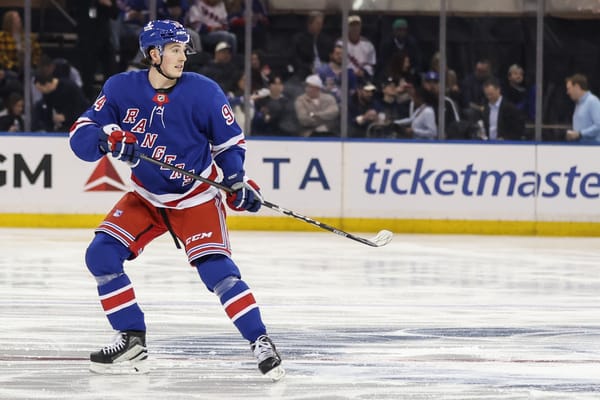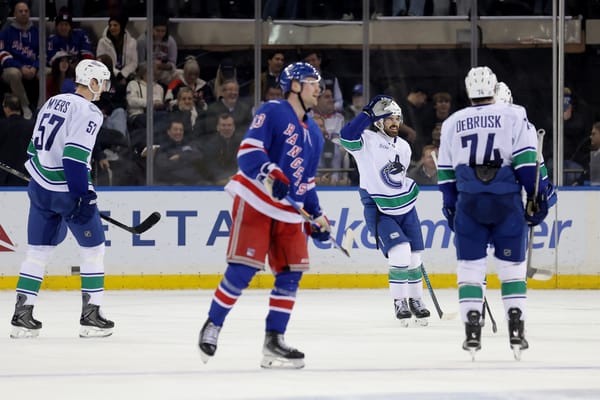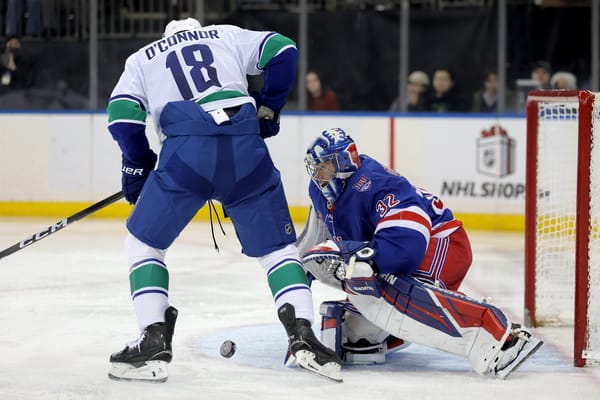A Walkthrough of the Rangers’ Rationale for the Impending Lundqvist Buyout
The Rangers’ reasoning is more than meets the eye.
By now, the fate of Henrik Lundqvist is the worst kept secret in hockey. Barring an extreme change in circumstances in the next month or two, the Swedish netminder will be leaving the franchise he’s back boned since the 2005-06 season. The New York Post’s Larry Brooks all but confirmed it in August and then again in early September. The Athletic’s Rick Carpiniello echoed the sentiment last Tuesday. Independently, Blueshirt Banter had been informed of this all-but-inevitability by multiple sources as far back as February.
A buyout is the most likely option, if not the already decided upon action, at this point in time. Lundqvist still wants to play hockey and is apparently foregoing his chance to return to Sweden and play for Frolunda, who begin their season on September 19th. A trade is extremely unlikely, as he would seemingly prefer to pick his next team and make any potential transaction fiscally manageable for suitors who might not otherwise be able to afford him.
That presumed decision has been met with resistance from some fans. Concern appears centered around financial implications and the inevitability of Alexandar Georgiev’s eventual departure. Igor Shesterkin is the team’s future in net, so they might as well get it over with now, keep Lundqvist for the final year of his contract, and avoid the financial consequences of a buyout.
Not to say that there isn’t any merit within those arguments, but those points oversimplify the dilemma the Rangers currently face. The reality of the situation is more complicated than it appears and the Rangers are considering more than what appears at face value. The purpose of this article is not to persuade anyone’s opinion — although, for full disclosure, I personally think the Rangers are making the right decision. Rather, the intention is to explore the arguments and provide a more complete, nuanced layout of the Rangers’ reasoning in reaching this decision.
Argument One: Georgiev is The Latest Disposable Backup
The idea is that Igor Shesterkin is the goalie for now and well into the future. The Rangers made quick work of developing Cam Talbot before trading him. They did the same with Antti Raanta. Alexandar Georgiev is no more than the latest example on the Rangers’ rapidly moving assembly line for backup goaltenders that always get replaced.
Kevin is one of many to have voiced this argument.
the Rangers did it with Talbot, they did it with Raanta, and they should probably do it with Georgiev. The market is always flush with guys you can sign for cheap as backups, this year the crop is even bigger than normal.
— Kevin (@Kpower90) September 5, 2020
How the Rangers See It:
No doubt, the Rangers are moving forward with Shesterkin as their guy in net. Still, **** happens. Any goaltender is one hip injury away from hell. Locker room problems turn up. Contract negotiations turn ugly. A drop in form comes out of nowhere. Who would have predicted in 2018 that Tristan Jarry, NOT Matt Murray, would be the Penguins’ goalie of the future? The Rangers don’t want to be stuck without a Plan B any sooner than they need to be.
But yes, in all likelihood Shesterkin will clinch the permanent starting job beyond any reasonable doubt and Georgiev could soon enough be overqualified for his role on the team. Like Talbot and Raanta before him. So why not trade him now, collect compensation, and move on with life?
Georgiev’s situation is different than Talbot’s or Raanta’s. First, he’s at a different stage of his career. Both Talbot and Raanta were 28 years old and a year away from unrestricted free agency when the Rangers traded them at the 2015 and 2017 NHL Drafts respectively. Georgiev, on the other hand, is 24 years old and three years removed from unrestricted free agency.
Shayna brought up a fair point, asking what happens to Georgiev’s trade value if the Rangers keep him and his play regresses.
It’s a risk the Rangers are willing to take. As Blueshirt Banter had previously reported in January, multiple sources have confirmed that the Rangers think more highly of Georgiev than they ever did Raanta or Talbot, and that’s not a diss towards that latter two. In a world where Shesterkin wasn’t a Ranger, the organization would be completely comfortable with Georgiev as their future netminder. Goaltending Coach Benoit Allaire is a huge fan of the Russian’s mechanics and work ethic and thinks that he has the potential to become an above-average starting NHL goaltender.
The Rangers didn’t get anywhere near the value they deemed requisite for a Georgiev trade in the winter, when he was almost the only credible goaltender available. It’s unlikely that will manifest in an offseason flowing with potentially available goaltenders.
The Rangers traded Raanta and Talbot in part because they were backed into a corner by expiring contracts, but also because they believed they were trading them at peak value. They don’t believe that to be the case for Georgiev, who is younger and who they believe has tons of untapped potential still. They’re prepared to bet on Allaire’s ability to get even more out of him, reap the rewards of his strong play for another season or two, and then trade him for a superior return than they believe they would get right now.
Argument Two: The Cost of a Buyout isn’t Worth it
The Rangers are already tight on cap space. Buying out Lundqvist would come with a hefty $5.5M cap penalty for next season, not to mention a $1.5M penalty for the 2021-2022 season. It’s a cost too steep. Especially for the sake of keeping a player who, as already mentioned, will probably be a trade casualty very soon anyway.
How the Rangers See It:
The way I’ve seen some frame the economics of this decision is very misleading.
Yes, the Rangers will be charged a $5.5M cap penalty next season if they buy out Henrik Lundqvist. However, they don’t gain that cap space by keeping him. By keeping Lundqvist, his usual $8.5M cap hit would remain.
No matter what the team decides, at least $5.5M of Lundqvist’s cap hit will count. The question is whether the organization would prefer to keep Lundqvist at $8.5M or free up $3M of cap space.
Re-signing Georgiev to a short-term deal won’t cost more than that $3M. In fact, it’s quite easy to see him coming in at an even lower amount. In that case, the Rangers would actually be saving cap space for the 2020-21 season by buying out Lundqvist. Maybe not a ton, but every dollar counts in the current climate. At worst, the “penalty” everyone is dreading is non-existent for this offseason.
The $1.5M cap penalty for 2021-2022 is not ideal. However, a lot of cap space comes off the books next offseason as well.
On top of that, both Marc Staal’s and Brendan Smith’s contracts will expire, opening up another $10.05M of cap room. It’s a shame to waste any cap space, but Lundqvist’s buyout is not as crippling as is being portrayed.
Are the Rangers willing to eat $1.5M in cap space two seasons from now in order to keep Georgiev and maybe even save a bit of space for next season? Evidently, the Rangers’ answer is an emphatic yes.
Argument Three: Trading Georgiev Would Solve the Goaltending Logjam
The Rangers have three goaltenders on the NHL roster. That’s one too many. Moving on from one fixes that problem, and trading Georgiev would avoid the mess of buying out Lundqvist and let him finish his career with the Rangers as Shesterkin’s backup.
How the Rangers See It:
It is true that trading Georgiev would solve the Rangers’ numbers problem in net. It still does not necessarily solve the Rangers’ Lundqvist dilemma.
Nobody is asking you to cry for backup goaltenders, whose jobs are better paying and more entertaining than that of most people.
But the reality of the gig is that it’s often an absolute grind. You have to withstand numerous hours of tedious practice time, video sessions, and travel away from family without the payoff of actually getting into game action most of the time. You have to check your ego at the door and be a positive influence from the bench and in the locker room. You have to endure lots of post-practice bag skates and serve as a crash test dummy in the crease when the team practices the power play or the healthy scratches try to get extra work in. You have to be able to switch on for starts after long layoffs.
If you’re a young player or a journeyman, you take what you can get and you’re grateful, knowing that you’ve temporarily secured a fleeting opportunity for one of just 62 NHL goaltending jobs in the world.
Henrik Lundqvist is neither of those. He’s a 38-year-old who has been living the life of a superstar nearly his entire career. Prior to the latter half of this season, his status as the starting goaltender for his team has not been seriously questioned since 2005. How many in the same galaxy as Lundqvist have willingly accepted, let alone thrived in, a full-time backup job in the NHL at such an advanced age? Only Ryan Miller comes to mind.
Even if Lundqvist could battle age and conquer the role of backup goaltender physically, there is little belief that he would accept it mentally. There’s always a possibility that a long offseason could offer Hank a refreshed perspective, and if afforded the chance to see other opportunities, he could discover that the grass is not greener elsewhere. But as of now, even if the Rangers did find a trade partner for Georgiev, nobody is particularly optimistic that Lundqvist would be content to play second-fiddle and mentor to Igor Shesterkin.
“No chance,” as one source put it.
Could the Rangers tell him he’s under contract and to deal with it? Technically, yes, they could. But the team respects his professionalism through a turbulent past few seasons and have no desire to extend his misery further. More selfishly, they recognize that a tense Lundqvist would dishevel locker room dynamics.
The Big Picture
The Rangers, who wish to be competitive next season, see Georgiev as a better goaltender than Lundqvist at this point in both of their respective careers. They believe that, even if Georgiev is probably not part of the long-term picture, it’s still worth seeing out more of his development under the watch of Benoit Allaire as an investment in an asset they believe could hold quite a lot of value in the future.
Yet truthfully, it’s possible to envision a scenario where the Rangers find a trade they can’t refuse for Georgiev and still execute a buyout for Lundqvist nonetheless. This isn’t just about Georgiev, the salary cap, or three goaltenders trying to fit into two roster spots. There is still time for minds to change, but the Rangers’ impending buyout of Lundqvist is as much about a mutual understanding of conflicting aspirations for player and team as it is anything to do with roster capacity.




